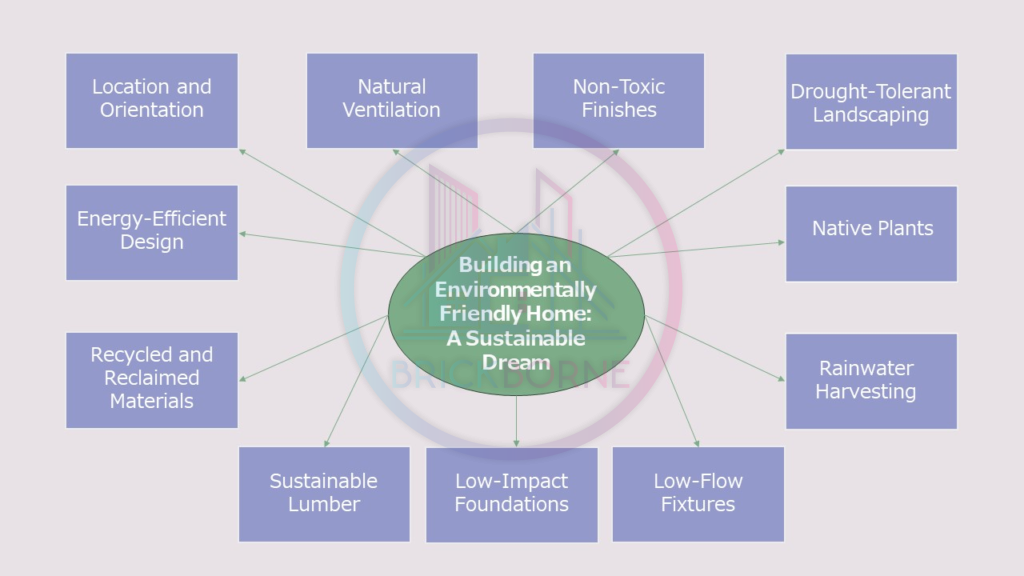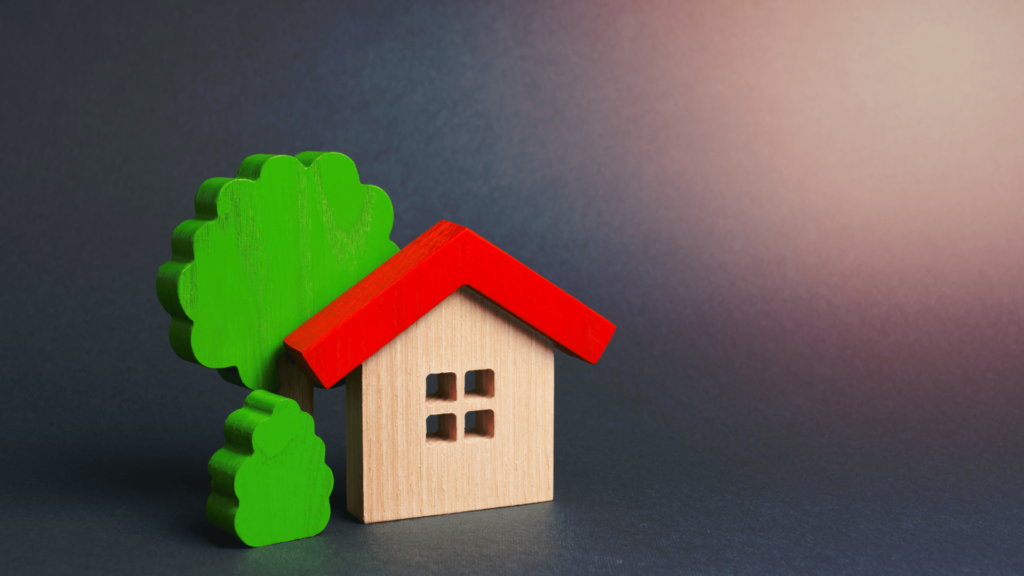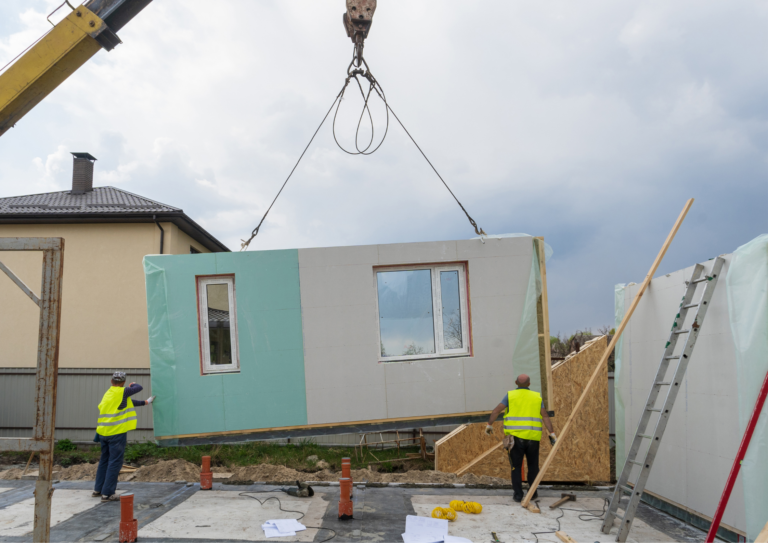There is no other choice left other than to go for sustainable construction techniques to save the environment. It has become necessary to take actions that make the environment healthier and greener. Constructing an environmentally friendly home is one of the practices that will ensure a safer environment for future generations. Everyone among us requires an indoor area where we may feel protected from impacts that are harming the world around us.
Let’s discuss the important aspects you should keep in mind while planning an environmentally friendly home for you and your family!

The Foundation of Sustainability
Location and Orientation
The first step towards an eco-friendly home is selecting the proper location and orientation of the house. You should select a site where any construction activity should not disturb the surrounding ecosystem. One other important aspect that should be kept in mind is that the orientation of the home should be such that it utilizes the maximum sunlight and wind energy. In this way, the usage of electricity can be minimized.
Did you know that a well-oriented home can reduce heating and cooling costs by up to 30%?
Energy-Efficient Design
As the world is facing a decrease in fossil fuels, this is the need of the hour to look for natural resources that would be beneficial for fulfilling the energy needs in the future. Energy-efficient design can lead to annual energy savings of around 20-30%, reducing both your carbon footprint and energy bills. Thus, you can say that the energy-efficient design of the house is the second most important factor you should consider while opting for an eco-friendly home. This includes selecting the most suitable house dimensions and placement of rooms, doors, and windows in such a way that maximum use of daylight can be ensured. You can also look for technologies like energy-efficient windows and doors that also contribute to reduced energy consumption in building an eco-home.
Solar panels can reduce your electricity bills by 50-75% and pay for themselves in as little as 5-7 years.
Sustainable Building Materials
Recycled and Reclaimed Materials
Using eco-friendly materials for building construction can be a great step towards achieving sustainability goals. Using recycled materials like recycled plastic, reclaimed wood, and recycled steel, emissions of greenhouse gases can be immensely reduced. Furthermore, these materials are cost effective which will save the overall cost of your home.
The use of reclaimed materials can save up to 85% of energy compared to using new materials.
Sustainable Lumber
This is the most suitable building material as compared to cement, steel, or plastic. The reason lies in the fact that it is a naturally occurring material and we can grow as much wood as we want. However, if you plan to use wood to build an environmentally friendly home, always use those forests that are government approved. Thus, this is the most recommendable building material you must consider while designing an eco-friendly home.
Low-Impact Foundations
Low-impact construction means that there will be minimum use of energy during the construction of buildings. For that purpose, we can select the type of foundation that minimizes the use of cementitious products for the environment. Low-impact foundations will ensure that there is a minimum disturbance in the soil profile. In this way, economy as well as sustainability can be achieved.
Traditional concrete foundations can produce up to 8% of global CO2 emissions. Low-impact foundations help reduce this environmental burden.
Water Conservation
Low-Flow Fixtures
Low-flow fixtures utilize less water as compared to their counterparts. In this way, a significant amount of water can be saved. So, when you are planning to build an eco-home, you should consider low-flow fixtures to be installed in your showerheads, and toilets to reduce water consumption.
Low-flow fixtures can reduce water usage by up to 50%, saving both water and energy used for water heating.
Rainwater Harvesting
Rainfall is a natural process in which we can collect water for our daily usage. This will save thousands of gallons annually resulting in the reduction of overall water demand of an area. Collected rainwater can be used for multiple purposes including landscaping, and flushing. Thus, rainwater harvesting is a smart choice when building an eco-home on a budget.
Sustainable Landscaping
Native Plants
When it comes to building an eco-friendly house, greenery is a must-do element. However, it is suggested that you should use those plants for plantation that are native as those plants will be adaptable to that environment, thus it will require less water and maintenance as compared to non-native plants.
Native plants can reduce outdoor water use by up to 50%, while also providing essential habitat for pollinators.
Drought-Tolerant Landscaping
Drought-tolerant landscaping involves those plants that require minimum water to live. In order to save water, a wise move when building an eco-home is to consider planting drought-tolerant plants.
Well-designed drought-tolerant landscaping can reduce water usage by 30-60% compared to traditional lawns.
Indoor Air Quality
Non-Toxic Finishes
Using non-toxic paints and finishes are vital consideration in building an environmentally friendly home. This will reduce the amount of Volatile organic compounds (VOCs) which are commonly used in paints. Thus, non-toxic finishes are a must to create a healthier indoor environment.
Natural Ventilation
Ventilation is air circulation into, out of, or within a room. Enhanced air circulation contributes to improved air quality. For air to properly circulate in a room, it is necessary to have a good ventilation system. Improving ventilation does not require major renovations. There are numerous simple ways in which we can improve the environment of our living space.
If you are planning to build an environmentally friendly home, then you are making a long-term investment that will benefit you in the long run. It can be said for sure that if you succeed in building a eco-friendly home then your future generations are going to live a peaceful and healthy life.






6 comments
How to Install Solar Panels on Concrete Tile Roofs
[…] energy is not only cost-effective but also environmentally friendly. Greenhouse gas emissions can be greatly reduced by increasing the use of solar panels. That’s […]
Earth Air Tunnels in the Modern World
[…] earth air tunnels not only reduce energy costs but also contribute to a greener and more environmentally conscious future. With architects, engineers, and builders continuously pushing boundaries in this […]
All you need to know about Pedestrian Bridge Construction
[…] concrete, and composites. Right now, the concept of sustainability has also opened new doors to eco-friendly materials that will be beneficial for both mankind and the […]
How to make a building Greener?
[…] constantly ask themselves, “How to make a building greener?” If you’re an enthusiast of green buildings and sustainable practices, searching for answers, then answers you shall get. How? Just read through the core principles and […]
How to make a building carbon neutral - brickborne
[…] the pursuit of resilient communities, the debate on carbon-neutral buildings has become hot among Engineers in the Construction Industry. It is a building that balances the […]
World of Smart Building IoT Sensors: Everything you need to know - brickborne
[…] These sensors have ushered in a new age. It is an age of revolution, intelligent automation, and Smart Infrastructure Technology, promising Facility Managers like yourself unprecedented insights. What are these insights, you may […]